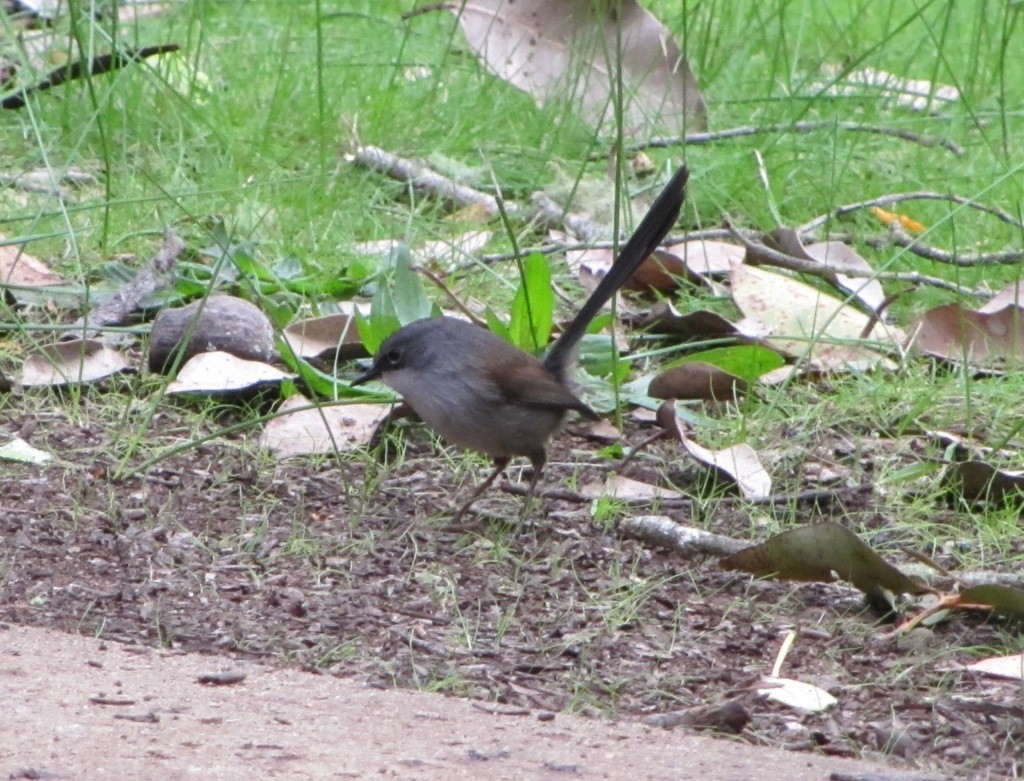Red-winged Fairywren
A species of Fairywrens Scientific name : Malurus elegans Genus : Fairywrens
Red-winged Fairywren, A species of Fairywrens
Botanical name: Malurus elegans
Genus: Fairywrens
Content
Description General Info
 Photo By kdunnart , used under CC-BY-NC-4.0 /Cropped and compressed from original
Photo By kdunnart , used under CC-BY-NC-4.0 /Cropped and compressed from original Description
The red-winged fairywren is 15 cm (6 in) long and weighs 8–11 g (0.28–0.39 oz), making it the largest of the fairywrens. The average tail length is 7.5 cm (3.0 in), among the longest in the genus. Averaging 10 mm (0.4 in) in males and 9.3 mm (0.4 in) in females, the bill is relatively long, narrow and pointed, and wider at the base. Wider than it is deep, the bill is similar in shape to those of other birds that feed by probing for or by picking insects off of their environs. Like other fairywrens, the red-winged fairywren is notable for its marked sexual dimorphism, males adopting a highly visible breeding plumage of brilliant iridescent blue and chestnut contrasting with black and grey-brown. The brightly coloured crown, ear tufts and upper back are prominently featured in breeding displays. The male in breeding plumage has a silvery blue crown, ear coverts and upper back, a black throat and nape, bright red-brown shoulders, a long grey-brown tail and wings, and a greyish-white belly. Non-breeding males, females and juveniles are predominantly grey-brown in colour, though males may retain traces of blue and black plumage. All males have a black bill and lores (eye-ring and bare skin between eyes and bill), while females have a black bill, rufous lores and pale grey eye-ring. Immature males will develop black lores by six weeks of age and generally moult into an incomplete breeding plumage the first breeding season after hatching. This has a patchy or spotty appearance, with a mixture of blue and grey feathers on the head, and black and grey on the breast; birds born early in the breeding season will gain more nuptial plumage initially than those born late. Most perfect their nuptial moult by their second spring, though some may need another year. Several males have been observed in breeding plumage in a single group at the same time, although it is unknown if or how this is related to dominance or breeding status. Both sexes moult in autumn after breeding, with males assuming an eclipse non-breeding plumage. They will moult again into nuptial plumage in winter or spring. Body feathers are replaced at both moults while wing and tail feathers are in spring only, though the latter may be replaced at any time if damaged or worn. The blue coloured plumage, particularly the ear-coverts, of the breeding males is highly iridescent due to the flattened and twisted surface of the barbules. The blue plumage also reflects ultraviolet light strongly, and so may be even more prominent to other fairywrens, whose colour vision extends into this part of the spectrum. 
Size
16 cm
Life Expectancy
10-16 years
Nest Placement
Shrub
Feeding Habits
Red-winged Fairywren, a restless feeder, forages on ground leaf-litter and ascends trees for bark arthropods. Prefers insects—ants, beetles, spiders, bugs, caterpillars—with seasonal diet variations. Unique in their burst of activity for easy prey, red-winged Fairywren groups shelter during heat, foraging continuously in winter, heavily reliant on ants.
Habitat
Red-winged Fairywren thrive in dense understorey vegetation of tall eucalypt forests, predominantly in the southwest. Preferring wetter gullies and riverine habitats within karri and jarrah woodlands, they avoid forestry plantations with scant undergrowth. Although logging and fire impact them, they recover with ecological restoration. Not found in dry scrub habitats, their conservation is focused on preserving key forest areas.
Dite type
Insectivorous
General Info
Feeding Habits
Bird food type
Behavior
Hopping, with both feet leaving the ground and landing simultaneously, is the usual form of locomotion, though birds may run while performing the "rodent run display" detailed below. Its balance is assisted by a proportionally large tail, which is usually held upright and rarely still. The short, rounded wings provide good initial lift and are useful for short flights, though not for extended jaunts. 
Distribution Area
The red-winged fairywren occurs in the wetter, southwest corner of Western Australia, from Moore River north of Perth south through to the Margaret River region and east to Albany. It is common in parts of its range, though there is some evidence of decline from draining of swampland. It lives in the understorey of karri and jarrah. Older forests appear to be less favourable habitats, while birds appear to be attracted to disturbed areas after logging. Fire also results in populations disappearing, returning after a period of two years. Forestry plantations of pine and eucalypts are generally unsuitable as they lack sufficient undergrowth. Within the forest habitat, the red-winged fairywren prefers wetter gullies and riverside sword sedge. It borders the range of the variegated fairywren on the northern limit of its range, and the blue-breasted fairywren in the eastern limit, with those two species occupying dryer scrub while the red-winged fairywren is restricted to wetter forests. The lack of intermediate forms reinforces the status of all three taxa as separate species. Sites identified by BirdLife International as being important for red-winged fairywren conservation are Araluen-Wungong, Jalbarragup, Mundaring-Kalamunda, North Dandalup, the Stirling Range, Two Peoples Bay and Mount Manypeaks. 
Species Status
Not globally threatened.
Scientific Classification
Phylum
Chordates Class
Birds Order
Perching birds Family
Australasian wrens Genus
Fairywrens Species
Red-winged Fairywren